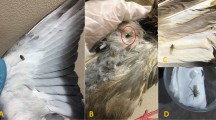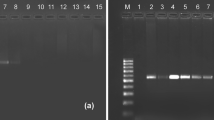Abstract
The forensic entomologist frequently bases time since death (TSD) estimation on fly larvae. In some cases, the food source on which these larvae have completed their development may be questionable, and requires verification to ensure the accuracy of the TSD estimation. Ingested DNA may be isolated from the alimentary canal of immature insects. Previous studies have confirmed the ability to extract ingested DNA from the alimentary tract of third instar blowfly larvae. This study considers the potential to detect ingested DNA from immature stages of the blue-bodied blowfly Calliphora dubia (Macquart) that had fed on sheep liver. Individuals from early first instar larvae through day 3 pupae were surface decontaminated, followed by DNA isolation and detection by amplifying the sheep satellite I region. Fragments of 197 basepairs (bp) and 87 bp were successfully isolated and detected in all stages of immatures until 2-day-old pupae, with detection at this stage being unsuccessful on 3-day-old pupae. This study presents a suitable protocol for the isolation and detection of ingested DNA from immature stages of C. dubia.
Similar content being viewed by others
References
Castner JL. General entomology and arthropod biology. In: Byrd JH, Castner JL, eds. Forensic Entomology: The Utility of Arthropods in Legal Investigations. New York: CRC Press, 2001, pp. 17–39.
Schoenly K, Goff ML, Wells JD, Lord WD. Quantifying statistical uncertainty in succession-based entomological estimates of the postmortem interval in death scene investigations: a simulation study. Am Entomol 1996;42:106–112.
Wells JD, Introna F, Di Vella G, et al. Human and insect mitochondrial DNA analysis from maggots. J Forensic Sci 2001;46:685–687.
Benecke M, Wells JD. DNA techniques for forensic entomology. In: Byrd JH, Castner JL, eds. Forensic Entomology: The Utility of Arthropods in Legal Investigations. New York: CRC Press, 2001, pp. 341–352.
Coulson RMR, Curtis CF, Ready PD, Hill N, Smith DF. Amplification and analysis of human DNA present in mosquito bloodmeals. Med Vet Entomol 1990;4:357–366.
Gokool S, Curtis CF, Smith DF. Analysis of mosquito blood-meals by DNA profiling. Med Vet Entomol 1993;7:208–215.
Kreife J, Kempfer S. Isolation and characterization of human DNA from mosquitoes (Culicidae). Int J Legal Med 1999;112:380–382.
Lord WD, Di Zinno JA, Wilson MR, Budowle B, Taplin D, Meinking TL. Isolation, amplification, and sequencing of human mitochondrial DNA obtained from human crab louse, pthirus pubis (L.), blood meals. J Forensic Sci 1998;43:1097–1100.
Dizinno JA, Wilson MR, Lord D, Badoule B. Mitochondrial DNA sequencing of beetle larvae (Nitidulidae: Omosita) attached to human bone. J Forensic Sci 2002;47:1337–1339.
Zaidi RH, Jaal Z, Hawkes NJ, Hemingway J, Symondson WOC. Can multiple-copy sequences of prey DNA be detected amongst the gut contents of invertebrate predators? J Mol Ecol 1999;8:2081–2087.
Linville JG, Wells JD. Surface sterilization of a mag got using bleach does not interfere with mitochondrial DNA analysis of crop contents. J Forensic Sci 2002;47:1055–1059.
Morris B, Dadour IR. Forensic entomology: The use of insects in legal cases. In: Freckelton I, Selby H, eds. Expert Evidence. vol. 4. Sydney: The Law Book Company Limited, 2005.
Carvalho F. A molecular method for the detection of ingested host DNA in the larvae and pupae of the forensically important blowfly species: Calliphora dubia (Diptera: Calliphoridae). Unpublished master’s thesis, University of Western Australia, Perth, Australia, 2003.
Chikuni K, Tabata T, Kosugiyama M, Momma M. Polymerase chain reaction assay for detection of sheep and goat meats. Meat Sci 1994;37:337–345.
Davies EE, Friend WG. Regulation of a meal: Blood feeders. In: Chapman RF, de Boer G, eds. Regulatory Mechanisms in Insect Feeding. New York: Chapman and Hall, 1995, pp. 57–189.
Greenberg B. Flies as forensic indicators. J. Med. Entomol. 1991;28:565–577.
Gullan PJ, Cranston PS. The Insects—An Outline of Entomology. London, Chapman and Hall, 1994.
Robertson CW. The metamorphisis of Drosophilia Melanogaster, including an accurately timed account of the principal morphological changes. J Morphology 1936;59:351–391.
Author information
Authors and Affiliations
Corresponding author
Rights and permissions
About this article
Cite this article
Carvalho, F., Dadour, I.R., Groth, D.M. et al. Isolation and detection of ingested DNA from the immature stages of Calliphora dubia (diptera: Calliphoridae). Forens Sci Med Pathol 1, 261–265 (2005). https://doi.org/10.1385/FSMP:1:4:261
Accepted:
Issue Date:
DOI: https://doi.org/10.1385/FSMP:1:4:261




